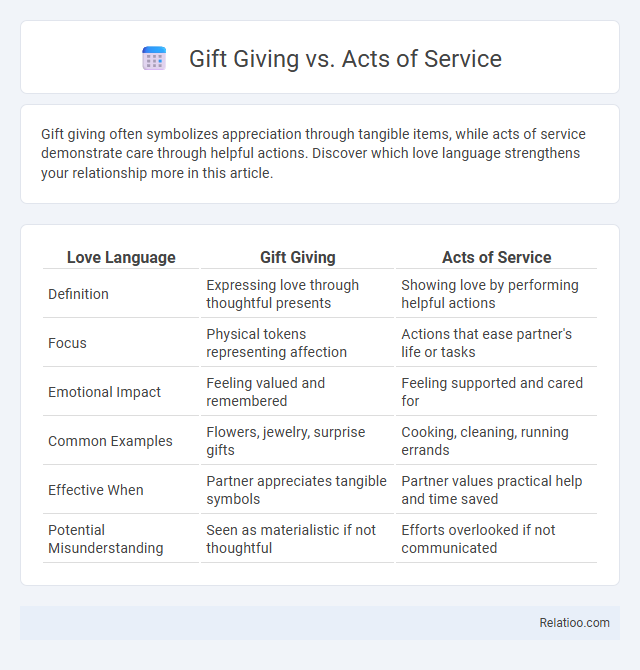Gift giving often symbolizes appreciation through tangible items, while acts of service demonstrate care through helpful actions. Discover which love language strengthens your relationship more in this article.
Table of Comparison
| Love Language | Gift Giving | Acts of Service |
|---|---|---|
| Definition | Expressing love through thoughtful presents | Showing love by performing helpful actions |
| Focus | Physical tokens representing affection | Actions that ease partner's life or tasks |
| Emotional Impact | Feeling valued and remembered | Feeling supported and cared for |
| Common Examples | Flowers, jewelry, surprise gifts | Cooking, cleaning, running errands |
| Effective When | Partner appreciates tangible symbols | Partner values practical help and time saved |
| Potential Misunderstanding | Seen as materialistic if not thoughtful | Efforts overlooked if not communicated |
Understanding Gift Giving: More Than Just Presents
Understanding gift giving extends beyond the exchange of physical presents to include acts of service, which can carry deeper emotional significance and demonstrate genuine care. Your choice between gifts and acts of service often reflects personal love languages and cultural values, emphasizing that meaningful gestures vary widely. Recognizing these distinctions helps you foster stronger, more heartfelt connections through thoughtful expressions of appreciation.
Acts of Service: The Language of Helpful Actions
Acts of Service, a key love language, emphasizes expressing affection through helpful actions rather than material gifts, strengthening emotional bonds by meeting practical needs. Unlike gift giving, which relies on physical presents to symbolize care, Acts of Service demonstrate commitment through thoughtful deeds like household chores or running errands. This tangible support fosters trust and appreciation, making it a powerful way to communicate love in relationships.
Gift Giving vs Acts of Service: Key Differences
Gift giving involves selecting and presenting tangible items as expressions of affection, often symbolizing thoughtfulness and appreciation, whereas acts of service prioritize performing helpful actions to meet the recipient's needs or ease their burdens. Gift giving provides a lasting physical reminder, while acts of service demonstrate care through time and effort, emphasizing practical support over material value. Understanding these key differences helps tailor expressions of love to individual preferences and strengthens interpersonal connections.
Cultural Perspectives on Gifts and Services
Cultural perspectives on gift giving and acts of service vary significantly across societies, influencing how these gestures are valued and expressed. In many Asian cultures, gift giving is a formal practice with deep social meanings tied to respect and relationship-building, while acts of service are often seen as less visible but equally meaningful expressions of care. Western cultures may prioritize physical gifts as symbols of affection during celebrations, whereas acts of service are frequently appreciated in close personal relationships for their practical support and emotional impact.
Psychological Impact of Receiving Gifts vs Acts of Service
Receiving gifts triggers a tangible sense of appreciation and value, reinforcing social bonds through physical tokens of affection and thoughtfulness. Acts of service, however, create a deeper emotional impact by demonstrating care and commitment through actions, often leading to increased feelings of trust and support. Your perception of these expressions varies depending on personal love languages, but acts of service generally foster stronger psychological connections than material gifts alone.
When Gifts Speak Louder Than Actions
Gifts communicate appreciation through tangible tokens, often creating lasting memories that acts of service may not provide. In certain cultures and relationships, material presents symbolize status, commitment, or affection more powerfully than actions. When timing or distance limits physical presence, well-chosen gifts can express emotions more effectively than deeds alone.
The Power of Acts of Service in Relationships
Acts of service hold significant power in relationships by demonstrating genuine care through actions rather than material gifts. When you prioritize helping and supporting your partner's needs, it fosters deeper emotional connection and trust that gifts alone cannot achieve. This focus on meaningful actions strengthens your bond and communicates love in a tangible, impactful way.
Choosing the Right Approach: Gifts or Service?
Choosing the right approach between gift giving and acts of service depends on understanding the recipient's love language and personal preferences, as individuals may value tangible presents or meaningful actions differently. Gift giving often expresses appreciation and thoughtfulness through material tokens, while acts of service convey care by actively supporting or assisting the person in need. Evaluating the context, occasion, and recipient's personality helps ensure the gesture aligns with their emotional needs and fosters genuine connection.
Challenges and Misunderstandings in Gift Giving and Acts of Service
Challenges in gift giving often stem from differing expectations, where the giver's intention may not align with the recipient's preferences, leading to feelings of disappointment or obligation. Acts of service can be misunderstood if the recipient perceives them as controlling or insufficient, creating emotional distance despite the giver's efforts. Effective communication is crucial to bridge these gaps, ensuring that both gift giving and acts of service convey genuine care without causing unintended stress or misinterpretation.
Combining Gifts and Service for Meaningful Connections
Combining gift giving and acts of service creates a powerful way to deepen meaningful connections by addressing both tangible and emotional needs. Gifts often symbolize thoughtfulness, while acts of service demonstrate care through time and effort, making Your expressions of appreciation more impactful. Balancing these two approaches ensures that the gesture resonates on multiple levels, fostering stronger, lasting relationships.

Infographic: Gift Giving vs Acts of Service
 relatioo.com
relatioo.com